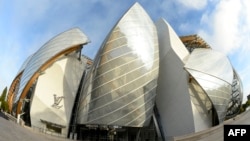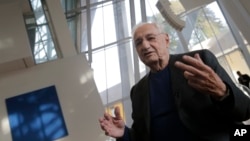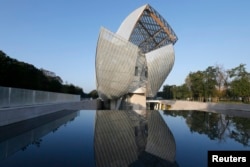Billowing sails of glass join the Eiffel Tower and the Sacre Coeur as permanent fixtures of the Paris skyline this month, when the new Fondation Louis Vuitton contemporary art museum designed by Frank Gehry opens to the public.
Thirteen years in the making, the museum is the brainchild of Bernard Arnault, the chief executive and founder of LVMH. France's richest man envisioned a bold new piece of architecture in the capital that would tie the world's largest luxury group with the cutting edge of art and design.
The private museum that opens to the public on Oct. 27 will be donated to the city of Paris in 50 years.
Reflecting sky, clouds and light, the airy and audacious building by Los Angeles-based architect Gehry jutting from a one-hectare plot on the western edge of the city resembles a swaying ship poised over a rectangular pool of water.
Anchored by imposing iron and wood girders that evoke Belle Epoque steelwork, and relying on aerospace technology for its construction, Gehry's masterstroke is the building's 12 undulating sails covering an area of 13,500 square meters.
The rectangular panels of glass made in specially-created ovens in Italy reflect the light in different ways as they appear to twist this way and that. They float over the body of the building, "the iceberg," constructed of fiber-reinforced concrete known as Ductal.
From the inside, cutaways allow glimpses of the surrounding Jardin d'Acclimatation in the Bois de Boulogne as well as the Eiffel Tower and La Defense business center.
"We had to make a building that was glass and ephemeral and then that became a sailing ship for me, a regatta," Gehry said at a press viewing of the museum on Thursday.
The architect behind the Guggenheim Museum in Bilbao and the Walt Disney Concert Hall in Los Angeles said "a sense of movement was important."
"It looks like it's moving slowly through the Bois de Boulogne and that it reflects the trees and garden," Gehry said.
Eleven galleries provide 3,850 square meters (41,441 square feet) of exhibition space to house temporary shows and a permanent collection, which will include works borrowed from Arnault's personal collection.
"It's Magnificent"
The ambitious project took 100 engineers assembled by Gehry and a total of 3,000 workers. French media reports say the project's original price tag of approximately 100 million euros ($127.5 million) has been largely surpassed.
"You don't put a price tag on a dream," Arnault said, when asked how much the project cost.
Besides technical challenges, the building faced opposition from neighborhood groups worried about less green space.
"The few people who decide to build audacious things are badly understood, and it's only when the project is finished that you hear, 'My God, it's magnificent!'" Gehry told Paris Match magazine this month.
The project, which has garnered kudos from around the world, also represents a major publicity coup for Arnault, 65, a sometimes controversial figure in French high society.
Arnault faced a backlash in the media two years ago for requesting Belgian nationality as France prepared to introduce a 75 percent supertax. He later withdrew the request, saying it was not motivated by tax concerns.
Arnault's ambitious project is one his arch rival, Francois Pinault, founder of PPR, which has now become the luxury group called Kering, never accomplished in Paris.
Also an avid contemporary art collector, Pinault envisioned a museum built on a former Renault plant in nearby Boulogne Billancourt. Delays and bureaucratic red tape hindered the project, however, and he eventually opted for Venice, where the Palazzo Grassi now holds the Pinault collection.








